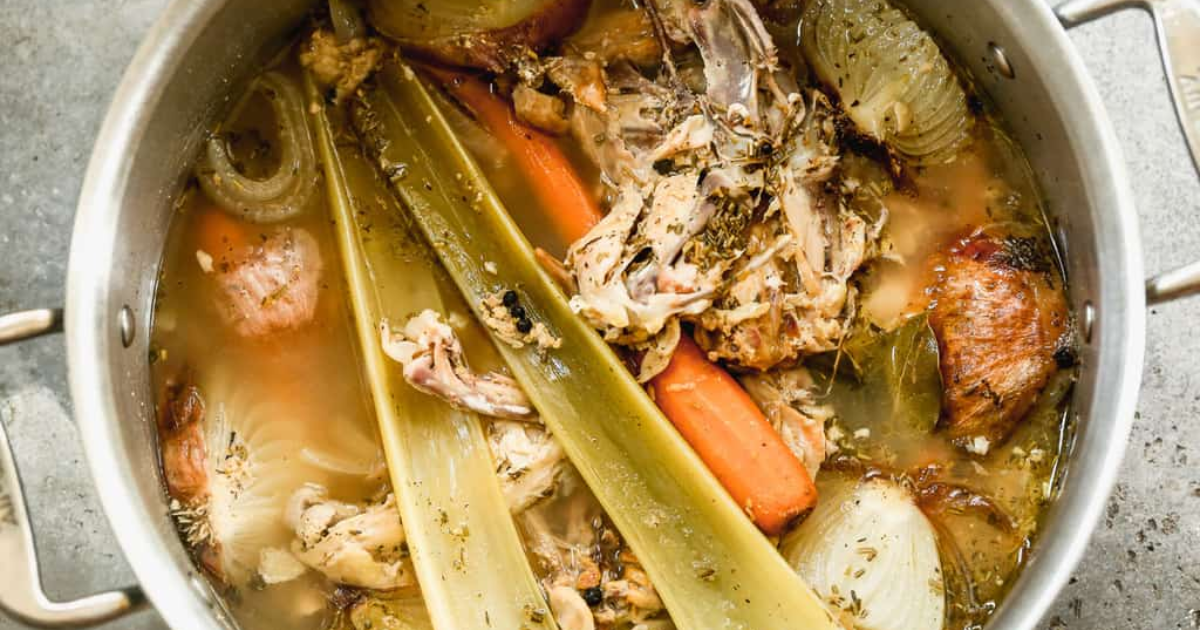Rotisserie chicken is a convenient meal choice, but don’t toss the leftover bones and skin! These parts are packed with flavor and nutrients, making them perfect for a rich, homemade chicken stock. This recipe for making chicken stock from rotisserie chicken is easy, waste-free, and adds a depth of flavor to soups, sauces, and other dishes. Here’s how to transform your leftover chicken carcass into a delicious homemade stock.
Why Make Chicken Stock from Rotisserie Chicken?
Using a rotisserie chicken carcass is a fantastic way to maximize the flavor of your stock. The slow-roasting process used for rotisserie chickens infuses the bones with a deep, savory taste that will elevate any dish you add the stock to. Plus, homemade stock is free from preservatives and artificial ingredients, making it a healthier choice than store-bought versions.
Ingredients for Rotisserie Chicken Stock
Gather these simple ingredients to make your rotisserie chicken stock:
- 1 rotisserie chicken carcass (including bones, skin, and any leftover meat)
- 1 large onion, roughly chopped
- 2–3 carrots, chopped into chunks
- 2–3 celery stalks, chopped into chunks
- 3–4 garlic cloves, smashed
- 1–2 bay leaves
- Fresh herbs (such as a few sprigs of parsley, thyme, or rosemary)
- 8–10 cups of water (enough to cover the ingredients)
- Salt and pepper, to taste
- Optional: Whole black peppercorns, a small piece of ginger, or a splash of apple cider vinegar to enhance flavor and nutrient extraction
Step-by-Step Guide to Making Chicken Stock from Rotisserie Chicken
Follow these simple steps to make your rotisserie chicken stock:
Step 1: Prepare the Chicken Carcass
After enjoying your rotisserie chicken, remove any leftover meat from the bones. Save the bones, skin, and any bits of meat for the stock. Pro Tip: Don’t worry about cleaning the carcass too thoroughly; any leftover meat or skin adds flavor and richness to your stock.
Step 2: Sauté the Vegetables (Optional)
For a deeper flavor, start by sautéing the onions, carrots, and celery in a large pot with a little oil. Sauté for about 5–7 minutes, or until the onions are translucent. This step is optional but adds a richer, caramelized flavor to the stock.
Step 3: Add the Chicken Carcass and Water
Place the rotisserie chicken carcass and any reserved skin into the pot with the vegetables. Add the garlic, bay leaves, and any fresh herbs, then pour enough water into the pot to fully cover the ingredients, about 8–10 cups.
Step 4: Season and Simmer
Add a pinch of salt and pepper to the pot (you can adjust to taste later). Bring the water to a gentle boil over medium-high heat, then reduce the heat to low, allowing it to simmer. Cover the pot and let the stock simmer for 1 to 2 hours. The longer it simmers, the more flavor and nutrients will be extracted.
Pro Tip: Skim any foam or impurities that rise to the top during the first 15–20 minutes of simmering. This will keep your stock clear and enhance its flavor.
Step 5: Strain the Stock
Once the stock has simmered to your desired flavor, carefully strain it through a fine-mesh sieve or cheesecloth into a large bowl or another pot. Discard the solids (chicken bones, skin, and vegetables) after straining.
Step 6: Cool and Store
Allow the stock to cool to room temperature before storing. Once cool, transfer it to airtight containers or freezer bags. You can refrigerate the stock for up to 5 days or freeze it for up to 3 months.
Tip: If you want a low-fat stock, let the stock cool in the refrigerator overnight. The fat will solidify on top, allowing you to easily skim it off before using.
Tips and Variations
- Add Vinegar: Adding a splash of apple cider vinegar helps extract minerals from the bones, adding more nutrients to your stock.
- Use a Slow Cooker: If you prefer, make this stock in a slow cooker on low for 8–10 hours for a richer flavor.
- Pressure Cooker: For a faster option, use a pressure cooker. Cook on high pressure for about 45 minutes for a rich, flavorful stock.
- Add Aromatics: Customize the flavor by adding herbs like rosemary, thyme, or a piece of ginger for a unique twist.
How to Use Your Rotisserie Chicken Stock
Rotisserie chicken stock is versatile and can enhance the flavor of many dishes. Here are some ways to use it:
- Soups and Stews: Use it as a base for any soup or stew, adding a deep, rich flavor to the broth.
- Cooking Grains: Replace water with chicken stock when cooking rice, quinoa, or couscous for added flavor.
- Sauces and Gravies: Incorporate it into sauces, gravies, and pan sauces to create a richer taste.
- Sautéing Vegetables: Use a splash of chicken stock when sautéing vegetables to keep them moist and add flavor.
Pasta: Add a bit of stock to pasta sauces or even use it to cook pasta for extra richness.

Leave a Reply